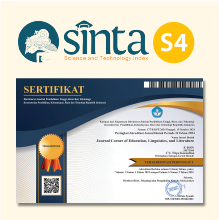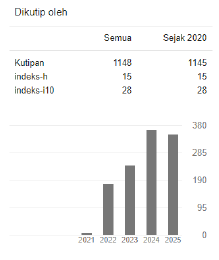Grebeg Mantra Memetri of Wonosari Residents Village, Tutur District: A Semiotic Studies
 https://doi.org/10.54012/jcell.v3i2.213
https://doi.org/10.54012/jcell.v3i2.213
 Abstract views: 196
Abstract views: 196
 PDF downloads: 218
PDF downloads: 218
Keywords:
Grebeg, Mantra, Memetri, SemioticsAbstract
This study aims to find the meaning of the mantra sign in the tradition of Grebeg Memetri. This research uses a qualitative approach. The data source in this study is the spell of slaughtering a cow's head in the Grebeg Memetri tradition. The data collection technique was carried out by primary observation of the Grebeg Memetri tradition done by residents of Wonosari village in Tutur district. The observation is done by conducting audio-visual and picture recordings using tape recorders and handy cams as well as exploratory interviews related to the Grebeg Memetri tradition done by residents of Wonosari village in Tutur district. Based on the results of the analysis, there are five code systems, namely the HER code, which indicates the existence of an enigma in it; the proaretic code (ACT), which regulates the flow of a story or narrative and guarantees that the text read is a story, the semik code (SEME) that makes use of cues, clues, or flashes of meaning elicited by certain markers, cultural code (REF) as markers that refer to a set of references or general knowledge, and symbolic code (SYM) that refers to a set of references or general knowledge that supports the text.
Downloads
References
Amir, Adriyetti. (2013). Sastra Lisan Indonesia. Yogyakarta: Andi Offset.
Barthes, Roland. (1974). M/Z. Yogyakarta: Jalasutra.
Danandjaja, James. (2007). Folklor Indonesia, Ilmu Gosip, Dongeng, dan lain-lain. Jakarta: Grafiti.
Hasuna, Kamal H dan Komalasari Ida. (2018). Analisis Sastra Lisan Dindang Pada Masyarakat Banjar Di Kalimantan Selatan. Jurnal Stilistika Vol.3 Nomor 1, hlm.47-55.
Hutomo, Suripan Sadi. (1991). Mutiara Yang Terlupakan (Pengantar Studi Sastra Lisan). Surabaya: HISKI.
Kaelan. (2009). Filsafat Bahasa Semiotika dan Hermeneutika. Yogyakarta: Paradigma.
Krisyantono, Rahmat. (2009). Teknik Praktis Riset Komunikasi. Jakarta: Kencana Prenada Media group.
Kurniawan. (2001). Semiologi Roland Barthes. Magelang: Tera.
Noor, Firdaus dan Ratu Nadya Wahyuningratna. (2017). Representasi Sensualitas Perempuan Dalam Iklan New Era Boots Di Televisi (Kajian Semiotika Roland Barthes). Jurnal IKRA-ITH Humaniora Vol.1 Nomor 2, hlm.1-9.
Rusyana, Yus. (1970). Bagbaga Puisi Mantra Sunda. Bandung: Proyek Penelitian Pantun dan Foklor Sunda.
Semi, M. Atar. (1993). Anatomi Sastra. Padang: Angkasa Raya.
Showren, T. 2014. Oral Traditions Method to adoptation of construction of the history of non-literate tribes. International Journal of Social Science and humanity, 4(6), 478-481.
Siswantoro. (2010). Metodologi Penelitian Sastra Analisis Struktur Puisi. Yogyakarta: Pustaka Pelajar.
Sobur, A. (2004). Semiotika Komunikasi. Bandung: Remaja Rosda karya.
Taum, Yosept Yapi. (2011). Teori –teori Anlisis Sastra Lisan: Strukturalisme. Yogyakarta: Levi-Strauss.
Downloads
Published
How to Cite
Issue
Section
License
Copyright (c) 2023 Devito Andharu, Wahyu Widayati, M Reza Ishadi Fadillah, Rommel Utungga Pasopati

This work is licensed under a Creative Commons Attribution-ShareAlike 4.0 International License.
All articles published in the Journal Corner of Education, Linguistics, and Literature are licensed under the Creative Commons Attribution-ShareAlike License (CC BY-SA).

















